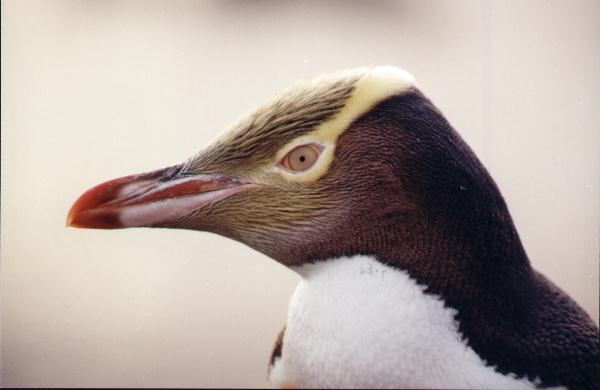
Megadyptes antipodes
TAXONOMY
Catarrhactes antipodes Hombron and Jacquinot, 1841, Auckland
Islands.
OTHER COMMON NAMES
French: Manchot antipode; German: Gelbaugenpinguin; Spanish:
Pingьino de Ojos Amarillos.
PHYSICAL CHARACTERISTICS
22.0–30.7 in (56–78 cm); female weight 9.3–15.5 lb (4,200–
7,500 g); male 9.70–18.7 lb (4,400–8,500 g). The only penguin
with yellow eyes; band of yellow feathers extends from one
edge of mouth to the other, passing through the eyes and
around the nape of the head. Head feathers are yellow with a
central black streak; back and tail are slate blue; flippers are
darker blue; and breast and belly are white. Long slender bill is
red-brown above cream shading to red-brown below. Pale pink
feet turn magenta with exertion. Juveniles lack yellow band of
feathers around nape.
DISTRIBUTION
Endemic to New Zealand and nearby smaller islands. Most
birds winter on or near the breeding grounds.
HABITAT
Breed in coastal areas of southern New Zealand and neighboring
subantarctic islands. Birds stay near breeding sites year
round, except for juveniles that move north to feeding grounds
for a few months after fledging. Nest from sea level to elevation
of 820 ft (250 m) on sea-facing, forested slopes and cliff
tops, usually amid dense forest vegetation. Probably choose
cool, shady forests to avoid overheating.
BEHAVIOR
Gregarious in winter (non-breeding season); roost communally
on flat, open ground and gather in groups of 50–100 on
beaches before departing for foraging areas. They forage alone
at sea. Secretive and especially wary of humans. During breeding
season they come ashore at night and negotiate difficult
terrain to reach cliff-top breeding areas. The least colonial of
penguins when breeding; nests are clustered together only because
appropriate habitat is limited. Calls are less harsh than
those of other penguins; Maori name, hoiho, means “noise
shouter.”
FEEDING ECOLOGY AND DIET
Eat mostly fish, some squid, and rarely crustaceans. While one
parent guards chick, off-duty bird heads to sea to forage in afternoon
and returns at dusk. Outside of the breeding season,
most birds head to sea at dawn and return before dark.
REPRODUCTIVE BIOLOGY
Nest out of sight of nearest neighbors amid dense vegetation.
Prefer hardwood (Podocarpus) forests (where nest sites are at the
base of trees or alongside fallen longs) but also nest in fields of
tussock grass. Nesting territory may be defended year-round.
Nest is a shallow bowl of twigs and other plant matter constructed
by both parents. Two eggs laid, three to five days
apart. Parents alternate incubation shifts of one to seven days
during 39–51 day incubation period and also take turns brooding
chicks for four to six weeks.
CONSERVATION STATUS
A 1990 study indicated the population had declined at least
75% over 40 years. Changed from Vulnerable to Endangered;
total breeding population estimated to be fewer than
2,000 pairs. Breeding range is very small, and habitat has
been degraded, especially by clearing of hardwood forests for
farming. In addition, cattle trample nests and introduced ferrets,
stoats, and feral cats are significant predators. Adults
also caught and killed accidentally in fishing nets. Ongoing
conservation efforts may be starting to reverse population
decline.
SIGNIFICANCE TO HUMANS
Yellow-eyed penguins have become a figurehead species of the
New Zealand environmental movement.
Other popular Animals
Photo Gallery of - Yellow-eyed penguin




 Animalia Life
Animalia Life